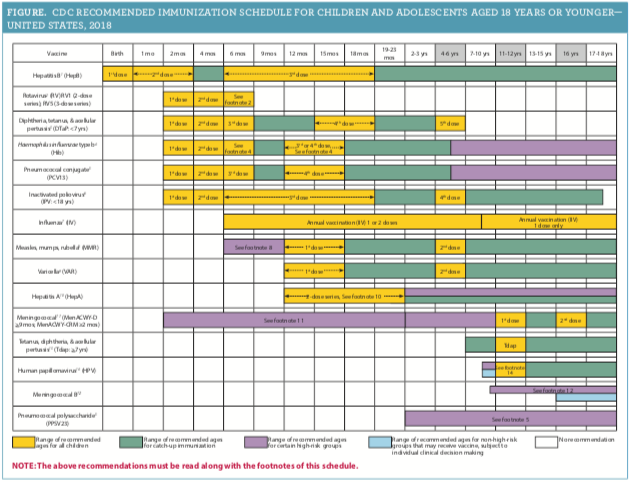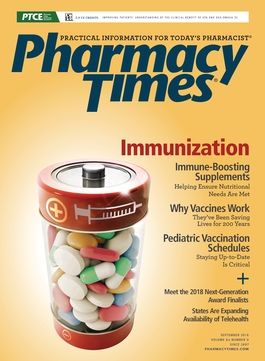Publication
Article
Pharmacy Times
Ensuring Children and Adolescents Are Up-to-Date on Vaccines
Author(s):
With summer ending, now is a great time to ensure that children and adolescents, from preschool through college age, are up-to-date on their vaccines for school.
With summer ending, now is a great time to ensure that children and adolescents, from preschool through college age, are up-to-date on their vaccines for school. Immunizing children helps protect public health, especially individuals who are too young to be vaccinated or who cannot be immunized because of medical conditions. Unfortunately, many outbreaks are because of unvaccinated individuals. Encourage parents to vaccinate their children on time accord- ing to the CDC’s recommended immunization schedule (figure).
VACCINE UPDATES
The Advisory Committee on Immunization Practices (ACIP) has approved the vaccine schedule for children and adolescents for 2018 and provided a notable update on the use of a third dose of the measles, mumps, and rubella (MMR) vaccine during a mumps outbreak.1-3 The MMR vaccine is given as a 2-dose series at 12 to 15 months and 4 to 6 years of age.1 Because of the increase in the number of outbreaks in the United States, ACIP recommends a third dose for individuals previously vaccinated with 2 doses who are at increased risk of acquiring mumps in an outbreak.3 Two doses of the MMR vaccine are about 97% effective at preventing measles, but the efficacy is lower for mumps at about 88%.3Additionally, the efficacy of the mumps component of the MMR vaccine may wane over time, which may be contributing to the outbreaks.3 ACIP also recommends universal hepatitis B (HepB) vaccination within 24 hours of birth for healthy infants weighing at least 2000 grams.4 Infants born to HepB-negative mothers weighing less than 2000 grams should receive 1 HepB dose at chronological age 1 month or at hospital discharge.4
The best way to prevent influenza is through immunization, so educating parents about the flu vaccine is important, especially that children should receive an annual vaccine by October, before flu season begins. Keep in mind that it takes about 2 weeks for the vaccine to become effective. The 2017-2018 flu season was intense, and the interim analysis as of February 3, 2018, showed an overall vaccine efficacy of about 36%.5 However, the efficacy among children 6 months through 8 years was higher, at 67% against influenza A and 42% for influenza B.5 As of April 14, 2018, there were 156 influenza-associated pediatric deaths during flu season,6 most among unvaccinated children.
During the ACIP February 2018 meeting, any licensed influenza vaccine, including the live attenuated influenza vaccine FluMist, was recommended for the 2018-2019 flu season.7 The nasal spray FluMist has not been recommended for the past 2 years because of study results demonstrating low efficacy. The vaccine has been reformulated, and it will be tested during the upcoming flu season if it is reintroduced. FluMist may be given to healthy, nonpregnant individuals 2 through 49 years of age.7 Clinics and pediatrician offices should ensure that the inactivated vaccine is available, as parents may not want their children to receive the nasal spray.
VACCINE HIGHLIGHTS
The diphtheria, tetanus, and acellular pertussis vaccine is a 5-dose series given at 2, 4, 6, 15 to 18 months, and 4 to 6 years.1 The fourth dose can be administered as early as 12 months if at least 6 months have elapsed since the third dose. Children 11 to 12 years of age should receive 1 dose of the tetanus, diphtheria, and pertussis vaccine. Pregnant women between 13 and 19 years should receive 1 dose of the Tdap vaccine during the pregnancy, preferably the early part of weeks 27 to 36, to provide protection against pertussis in newborns.1
Educate parents about the importance of children receiving the human papillomavirus (HPV) vaccine to protect against cancer.
Reassure parents that the vaccine does not lead to increased sexual activity. The CDC recommends that all adolescents be vaccinated at 11 to 12 years of age as a 2-dose series.1 The second dose can be administered 6 to 12 months after the first dose. Administering the HPV vaccine at an early age produces a higher immune response and offers greater protection. Individuals 15 years and older at the start of the vaccine series should receive 3 doses.1

RESOURCES FOR CLINICIANS AND PARENTS
Clinicians can use the free CDC Vaccine Schedules application at the point-of-care. The app includes catch-up vaccine charts, immunization schedules, and medical conditions. Clinicians and parents can create a free customized schedule of childhood vaccines through the CDC’s interactive schedule creator. The schedule can be printed and provided to parents to ensure that their children are up-to-date on all vaccines.
Jennifer Gershman, PharmD, CPh, is a drug information pharmacist and Pharmacy Times®contributor who resides in south Florida.







